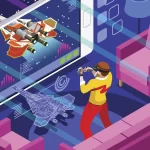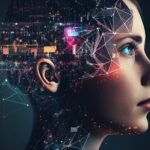AI in Augmented Reality: Enhancing AR experiences with AI-generated content and interactions.
Augmented Reality (AR) has been a catalyst for reshaping our perception of reality by overlaying digital elements onto the physical world. Yet, the fusion of Augmented Reality with Artificial Intelligence (AI) has ignited a new era of possibilities, revolutionizing how we interact with our surroundings. In this blog, we embark on a journey through the realm of AI in Augmented Reality, exploring how AI-generated content and interactions are propelling AR experiences to astonishing heights.
The Synergy of AI and Augmented Reality
AI and Augmented Reality, each remarkable in its own right, are proving to be an extraordinary pairing. As AI algorithms grow more sophisticated, they empower AR applications to perceive, understand, and respond to the environment in unprecedented ways. This synergy has ushered in a wave of innovation that is redefining user engagement and interaction.
- Real-time Object Recognition: AI enables AR devices to recognize objects and scenes in real time. This capability enhances user experiences by seamlessly integrating digital content into the physical world. For instance, pointing a smartphone at a historical landmark could trigger AI-generated information about its significance.
- Personalized Interactions: AI-driven AR can analyze user behavior, preferences, and context to tailor experiences. Whether it’s suggesting nearby points of interest or presenting targeted advertisements, AI ensures that AR content resonates with individual users.
- Content Creation and Enhancement: AI algorithms can generate and manipulate digital content in real time, enhancing the immersive quality of AR experiences. From lifelike avatars to dynamic visual effects, AI contributes to a richer and more engaging virtual layer.
- Gesture and Pose Recognition: AI-powered AR can accurately interpret user gestures and poses, enabling intuitive interactions. Users can control virtual objects, navigate menus, or play games with natural movements.
- Language Translation and Accessibility: AI’s language processing capabilities can be harnessed to provide real-time translations of signs, menus, or conversations, making AR experiences more accessible and inclusive.
Applications at the Intersection
- Retail and E-Commerce: AI-enhanced AR transforms shopping experiences by allowing customers to virtually try on clothes, visualize furniture in their homes, or receive personalized product recommendations based on their preferences.
- Education and Training: AI-driven AR can create interactive and immersive learning environments, where historical events come to life, complex concepts are visualized, and practical skills are honed through realistic simulations.
- Healthcare: AI-enabled AR can aid medical professionals by overlaying diagnostic data, 3D visualizations of anatomy, or real-time procedural guidance onto a patient’s body, enhancing precision and decision-making.
- Entertainment and Gaming: AI-generated characters, environments, and interactive elements can enhance the entertainment value of AR experiences, making gaming and digital storytelling more captivating.
Challenges and Considerations
While the integration of AI and AR opens doors to innovation, there are challenges to address:
- Real-time Processing: AI algorithms require substantial computational resources, which may impact the real-time performance of AR applications on resource-constrained devices.
- Data Privacy: The collection and analysis of user data for AI-driven interactions must be handled with care to ensure data privacy and security.
- Training and Adaptation: AI models need to be trained and adapted for different environments, lighting conditions, and user behaviors to provide consistent and accurate experiences.
Future Horizons
The trajectory of AI in Augmented Reality is poised for exponential growth. As AI models become more adept at understanding and responding to the world around us, AR experiences will become increasingly immersive, intuitive, and personalized. The synergy of AI and AR is likely to push the boundaries of what is conceivable, creating a future where the digital and physical realms seamlessly coexist.


































